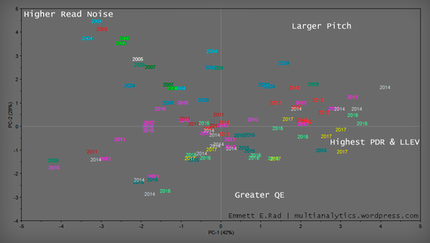One thing about time: data tends to collect. Sometimes you can gain insights into patterns or trends by analyzing that data.
Which is exactly what Emmett Rad did with years of photonstophotos data captured by Bill Claff: Multivariate Analysis on Image Sensor Classification and Variability. That paper uses a data set of nine different sensor variables that have been measured at base ISO.

I won't repeat all of Rad's results or commentary. Read his fascinating paper if you want that. But I was intrigued by a couple of things that seem clear:
- The progression on APS-C crop cameras seems extremely clear, at least for the Sony/Nikon cameras. What started as Read Noise restricted sensors has progressed fairly clearly towards the opposite quadrant, where photographic DR, Quantum Efficiency, and Low Light EV live. Clearly, that was an intentional goal of the Sony/Nikon efforts, and one that was also clearly realized. Rad predicts that the next Sony/Nikon sensor will move less towards QE and more towards DR. That's a reasonable prediction given the progression, though it will be interesting to see what happens if Nikon really does break off from Sony sensors and starts using their own designs fabbed at TowerJazz, as rumors seem to suggest.
- Look at the four quadrants in terms of time progression (Figure 8). Just as with the previous point, there's a clear pattern towards which variables are being pushed over time. The most recent cameras (2017) all tend to be lower and to the right of earlier cameras, and often grouped near the high DR, Low Light EV factors. Earlier cameras of any kind will tend to be above and to the left of the most recent ones.
This isn't rocket science. It's simply use of statistical analysis to reveal that the predicted patterns many of us have been talking and writing about indeed seem to be realized in the data. Sensor makers, again particularly Sony/Nikon where the trend is crystal clear, seem to have specific goals they've been pursuing as they try to make sensors better.





